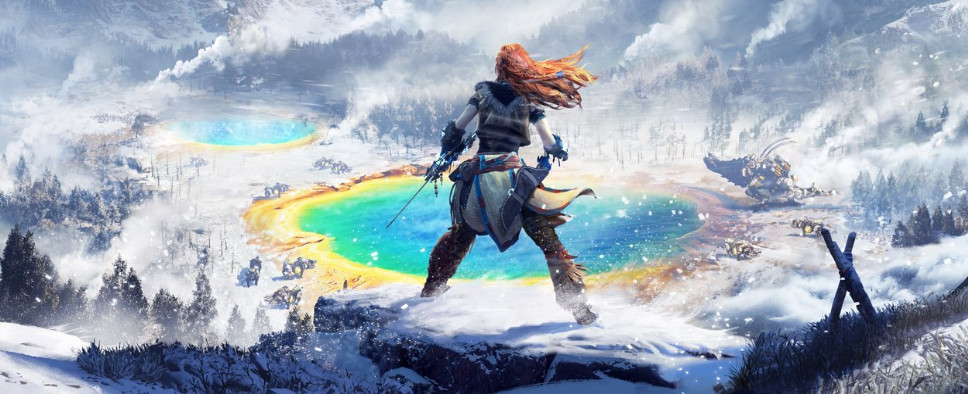Horizon Zero Dawn: The Frozen Wilds is an Unmissable Tech Showcase
-
Category: News ArchiveHits: 1498

This Eurogamer article offers a pretty in-depth look at the tech behind The Frozen Wilds expansion for Guerrilla Games' open-world action-RPG Horizon Zero Dawn. It covers snow physics, color palette, terrain deformation, monster AI and pathing logic, and the game's overall performance. Have a look:
So where does The Frozen Wilds innovate? First and foremost is the debut of new snow deformation technology. While moving through areas packed with deep snow, Aloy and other entities carve up the landscape in a realistic manner, leaving behind lengthy indents in the powder. These trails persist for quite some time after wandering through them as well. This means, following any skirmish, you can even follow the trail of deformation around the battlefield to retrace the fight. Beyond this, as the snow deforms in your wake, grass textures become visible beneath the surface creating the illusion of snow resting atop a once grassy plain.
Even better, as Aloy moves through the snow, her animation is adjusted to match. Her feet realistically kick up snow while pushing through it, while snowy textures are applied to her character model. The result is a convincing sensation of moving through a snowy landscape that was missing in similar areas featured in the original game. This is enhanced further by the snow showers themselves. Often thick, the use of lit snow particles does an excellent job of building just the right atmosphere for each scene.
All of this is complemented by a gorgeous colour palette. The artists have carefully selected just the right combination of colours for every scene - from the pink glow of sunrise to the freezing mountain tops, the depiction of dramatic light and colour is top notch here. Another nice addition to the game can be found in pools of water. While the implementation of screen-space reflections still falls short of expectations, these freezing pools and rivers now feature an interactive icy layer across the surface. As you walk through the water, Aloy leaves trails behind not unlike the snowy landscape. These trails are persistent as well - provided you remain in the general area.
Horizon's landscape is built on procedural rules, and these impact the icy weather conditions too. When faced with an enemy spouting fire and death, layers of ice on water surfaces appears to melt away - an impressive detail. Each of these new features help to enhance the Horizon experience by creating a more interactive and cohesive world, and following a visit to Guerrilla's Amsterdam studio earlier in the year, we now have a stronger sense of how the world of Horizon Zero Dawn works.
First, let's touch on the characters and creatures of the world. The robotic denizens of the world play a key role in defining the look and feel of Horizon and the way in which they engage the player is very important in maintaining this feeling. Each creature is designed to react to Aloy based on a set of pre-defined rules and boundaries. If a distant creature spots the player, it begins to approach to determine if you're a threat. You can then hide from this threat and avoid further conflict.
So how does it know to search for the player and what determines its behaviour? The video on this page visualises the process, but essentially, the enemy has a two-stage vision cone - the first, larger yellow cone represents its alert stage while the red barrier triggers an immediate reaction. If the player hides in long grass, the enemy is forced to search, and if it physically bumps into the player, or spots you within its immediate sphere, it switches to attack mode. This basic logic is applied to different enemies across the world with adjustments made based on the enemy type.
But what makes this more impressive is the pathing logic - the enemies can seamlessly navigate across the terrain while avoiding obstacles, but these obstacles can be adjusted in real-time. If an adjustment is made to the terrain, the AI can dynamically react and avoid this in a realistic manner complete with reaction animations and sound.
So we have some minor insight into how characters and quests might function but what about the visual make-up? Horizon features supremely detailed character models with very high triangle counts and a complex hair and clothing system designed to allow these elements to react naturally to physical movement.
When you break down the model into a wire frame, the sheer level of detail on display becomes evident. All of the characters in Horizon are modelled to an exceptionally high standard, in order to give the developers the freedom to use whichever characters they want at whatever prominence they want. The Frozen Wilds introduces new characters, but variations of older models are also present too.

